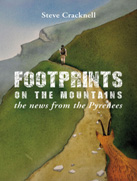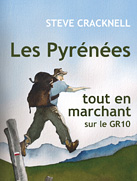Cet article est également disponible en: French
It is twenty years since bears were first reintroduced into the Pyrenees and yet the question of how to protect sheep is still being debated. Some breeders assert that a shepherd permanently on site with a patou (guard dog) and who brings his sheep together at night will have minimal losses, particularly when compared with natural mortality. This is the authorities’ official line.
Others, notably in Couserans (Ariège), say that cohabitation with bears is not possible especially in areas where the slopes are steep and rocky. The flocks disperse into smaller units (escabots) in search of sustenance. Some shepherds have tried to follow the official recommendations and report difficulties.
At present, if a bear could possibly be responsible for a sheep’s death, farmers receive compensation whether or not they have followed the recommendations. But is rumoured that in future the State will only indemnify those who have protected their flocks, which would be logical if it were clear that the measures work.
But do they? In the high Ariège the grumbling is becoming more vocal. The government has promised a commission of enquiry.
It seems to me an appropriate time to review the evidence. This article is devoted to the views of a shepherdess, now retired, who lives in the high Ariège and who thinks that the recommendations are useful. In a future article I will deal with the other point of view.
La Bergère et l’Ours
The book’s cover shows a young mother, smiling, with a shepherd’s crook in one hand and a baby with its teddy in the other. Behind her a real bear in the process of stealing a sheep is being pursued by a patou. Will the patou catch up with the bear? Perhaps. Perhaps not.
The story of this complicated love triangle between the bear, the sheep and the patou could have many endings. But in Catherine Brunet’s version all three will live together happily ever after.
***
Since she started saying that bears and sheep can live together, she has been repeatedly attacked verbally and has seen her car vandalised. The road leading to her house has been covered in graffiti. Now retired from the farm, she is no longer directly involved, although her son continues to raise goats.
I first came across her at the shepherds’ meeting in Foix on 9 December 2017. She insisted that the recommended protective measures had worked for her, amidst booing and hissing. The Ariège council president, who had organized the debate, felt obliged to intervene to insist that she had the right to express her opinion. I heard voices claiming “she can’t be a shepherdess” and “if there were no injuries it must be because there were no bears”.
She has just published a second edition of her book, which originally came out in 2015, so I have been reading what she has to say.
Thirty years in sheep-herding and sheep-breeding
Those farmers and shepherds in Ariège who are anti-bear typically disparage the views of outsiders who tell them how to run their businesses. They say, justifiably, that you need real experience of real sheep in real mountains to know what you are talking about. Which is why they find Catherine Brunet’s stance disturbing and why I want to detail her level of experience.
She was born on the family farm and one of the first jobs she did, and certainly first to capture her imagination, was helping a farmer in the lambing season. Subsequently she trained at the well-known School of Shepherding in Salon de Provence where she met her husband Arsène. Her first transhumance was in the Vercors with a flock of 1700 sheep.
The arrival of her first baby in March 1982 didn’t put an end to her interest in sheep, and with the baby just four months old she joined her husband in the Hautes-Alpes department at 2078m above sea level for the four summer months. The following year the couple arrived in Ariège, settling near to Mirepoix in the foothills. They took out a loan to buy their first flock, but couldn’t afford any land. So their flock of Montagne Noire sheep had to move around as grass became available.
- 1989: By now they have managed to buy some land, but not enough, and the cost of hay to supplement the grass is prohibitive. They change strategy, swopping their Montagne Noire for Tarasconnaises which are suitable for transhumance.
- 1991: Arsène finds an estive [mountain pasture] near Mantet (Pyrénées-Orientales) and Catherine goes to join him in the school holidays, with their three children in tow. “We stretched a tapraulin between four trees for the kitchen and so the children would have somewhere to play when it rained. Our table was a big flat stone. The chairs were boulders.”
- 1993: First estive above Siguer (high Ariège) with a home in the village itself. And so on until 2012 when she stopped working on the farm after thirty years, including twenty in the high Ariège.
It is perfectly clear to me that for her and her husband sheep farming wasn’t just a fantasy but a real job and their principal source of income.
Do bears shit in the woods?
Of course they do. But some anti-bear campaigners are reluctant to believe that bears shit in the woods above Siguer. As far as they are concerned Catherine Brunet can only be pro-bear because there were no bears in her neck of the woods.
So what is her response? The bear shitting in her woods, she says, was Boutxy, well known for his predilection for sheep in eastern Ariège and in neighbouring Pyrénées-Orientales. The last time he was seen it was in Siguer; he had been in the area from 2000. He disappeared in 2009. It is rumoured that somebody killed him.
As a proof of his presence Mme Brunet has included a photo of a footprint dating to 1 May 2009; the identification was confirmed by a specialist from the Brown Bear network who found others. She also quotes the eye-witness account of a fisherman at the lakes near her and her husband’s estive at the Étangs de Lassiès (2400m) on 20 July 2005.
“When I heard the dogs bark I turned round… I saw a dark mass with a lighter neck. It didn’t take me long to work out that it was a bear. He was about 250m away. He was ambling along (really calmly). That surprised me. I didn’t think that a bear could come so high in an area like this with no forest cover.
I thought I was going to see him attack the sheep because he was heading towards them.
When the bear approached the dogs stood up to him, barking menacingly. One of the three patous stayed behind in the flock and the sheep shifted a little.
Then the bear made for a hillock and charged and chased a patou. The other two came to back him up. The bear retreated and then launched a new attack, his last before ambling away and disappearing.
What surprised me was that during the whole confrontation the flock stayed calm.”
Catherine Brunet doesn’t claim that the presence of a patou, and a shepherd permanently in the estive and bringing the sheep back to the fold for the night will prevent all losses. She herself once had a sheep which came back to the sheep shed with a bite in its udder. But she never had any losses from the fold or sheep shed.
So, in her experience, the recommended protective measures work; it is possible for bears and sheep to coexist.
[Despite what you might think given the treatment of the subject in the media, the main reason for having a shepherd available 24 hours a day in the estive is not to protect the flock from a possible bear attack. A permanent presence allows him or her the time to round up the sheep to avoid overgrazing and above all the opportunity to treat sickness and injuries as soon as possible.]
***
Mme Brunet’s book doesn’t limit itself to these two subjects, far from it. She also explains why bears should be part of Pyrenean biodiversity. And she delves into the various confrontations between pro- and anti-bear groups, including some divergences in her own camp.
She often cites things she has written previously, of which she always keeps a copy. I have the impression that for her writing is visceral, instinctive. Putting her thoughts on paper has helped her to digest what has happened during the last twenty years.
She advocates a new vision of agriculture in the mountains:
“Do you think that a young person who sets himself or herself up in the mountains without incorporating respect for the environment (buildings and land, culture, wild animals and flowers) will be eligible to apply for quality certificates in the 21st century? I don’t believe that ‘living in the mountains’ on its own will qualify. I think that consumers are not stupid and that agriculture has suffered enough.”
See also: A former sheep-breeder defends the bears
See also the debate on France 5 TV
****
And elsewhere? In the Abruzzo in Italy, cohabitation seems to work.
The difference is that there have always been bears and wolves in the area, that they have a much higher proportion of patous to sheep, and that the mountains are less steep.
In Catalonia bears seem to be less of a problem as management improves. As in France, losses caused by some wild animals, including bears, is compensated when the responsibility is clear. In Catalonia, in 2009, the State paid out 97,000€ for 123 attacks; in 2015, the last year for which statistics are available, the payments totaled 2,700€ for just 18 attacks.














[…] « Can sheep be protected from bears in the Pyrenees? Yes, says Catherine Brunet […]
[…] shepherds say that some of their colleagues could do more to protect their sheep. Others, like Gisèle Gouazé whose cooperative lost 209 sheep in a single attack, say that the […]